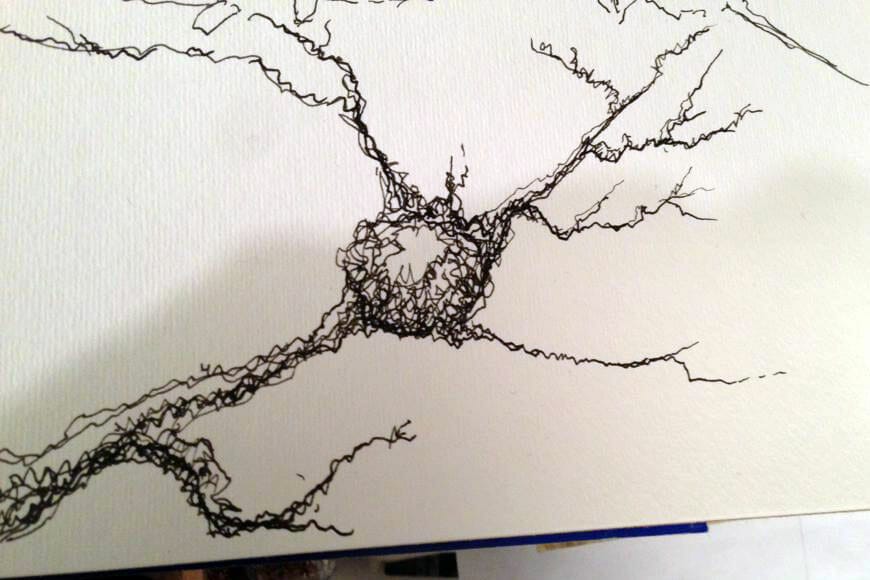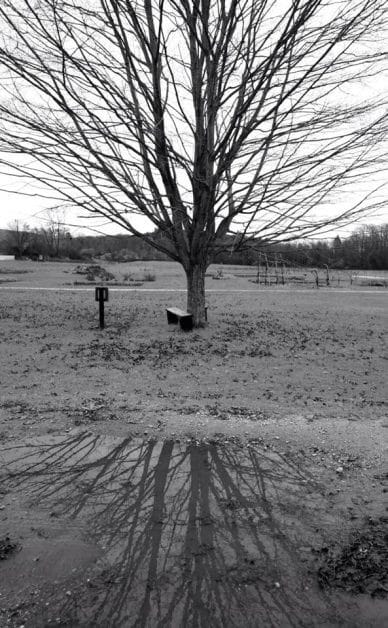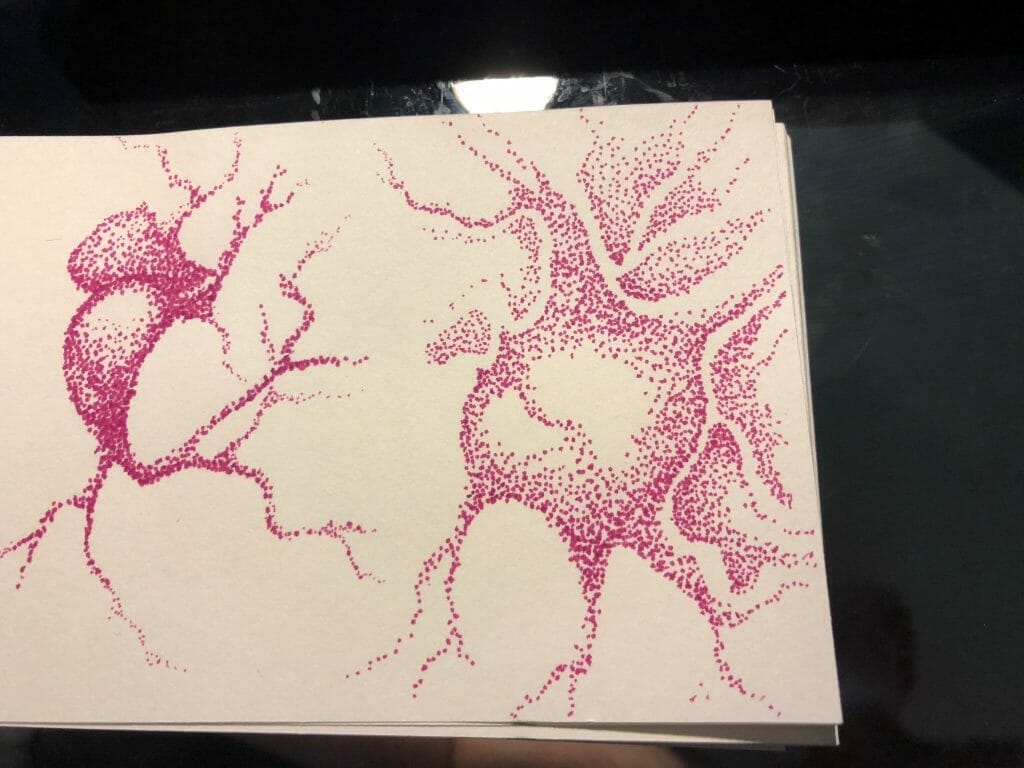If you’re looking for something to draw, science has a ton of easy subjects you can try. Scientific drawings of plants were my early favorites. The organic structure of trees and flowers made them easy for me to replicate on paper. My favorite subjects when I was a kid were bare trees in winter. I could use black inked pens or pencils to recreate the silhouettes of tree branches against a bright sky or winter scape.
Somehow, these early subjects stuck with me, as I realized that my eyes and mind were drawn to high-contrast subjects with branch-like forms. Such a unique interest has served me well in my career as a neuroscientist.
In this article, I write about my journey into fountain pens, which I am now learning to use to sketch and draw. As you will learn, my favored subjects are quite unique.
Try doodling branches, cracks, and lines connected in simple angled patterns.

3 Principle Reasons: Why Use a Fountain Pen?
Fountain pens are unique instruments that won’t go away anytime soon, despite our modern age of digital wordsmiths (aka computer word processing)
- Culture – Ancient tools with a modern spin, the fountain pens continue to play a large part in many parts of our culture
- Personal – Writers, artists, academics, and other professionals have embraced the fountain pen as a not only a flight-of-fancy, but a serious and even dearly-beloved instrument
- Environmental – A high-quality fountain pen can outlast a human lifetime, and is a cost-effective and sustainable means of protecting the environment
MORE: HOW A GOOD FOUNTAIN PENS CAN SAVE THE EARTH
On a whim, I decided to buy a new fountain pen. Based on online reviews, the TWSBI mini is one of the most popular modern fountains available. This particular fountain pen comes in a variety of colors and nib sizes (extra fine to a 1.1 stub nib). In my opinion, this pen is amazing. It’s versatile. If you were wondering about how well it writes, I can say that the fine nib “skates” across paper like it was made of ice.

It Began with Pain
I started writing with fountain pens back in graduate school. My first pen was a Lamy Safari. The pen was graphite colored and had a bright red clip.
Sadly, I lost it. Somewhere in a parking lot exiting a movie theater, it dropped out of a pocket in my backpack. I was still in a school, and losing that $20 pen was kind of disappointing.

That first Lamy traveled with me everywhere. When I traveled abroad to Nicaragua, South America, that pen was with me. I was on a field expedition on Ometepe Island, a small spit of land, in the middle of Lake Nicaragua.
There was no electricity, and since this was a University course, I was tasked with some research and writing assignments. Essentially, I was to journal about the local wildlife, e.g., monkeys and other animals, that lived around our stations.
Somehow, I had made an emotional connection to this pen.

That had never happened with my disposable pens. The fountain pen had smitten my sensibilities. Through ownership and constant use I had learned how that pen behaved when applied to paper.
Like a Samurai’s connection with his blade, or a wizard and his wand (a la Harry Potter world), my link to this pen had crystallized into a veritable relationship.
There was magic here.
This lost Lamy had started this painful journey of reforming some connection with the way I connected with words and drawn-images on paper.
There was no turning back to normal writing instruments. A computer is a poor writing substitute. A typewriter is close, but still second to the mighty fountain pen.
Doodling Versus Drawing
I had always doodled in school, sketching random abstract things. Circles, arrows to nowhere, in a Universe of lined sheets. The margins of reports and exams contained Worlds of my markings.
The difference between doodling and drawing is simple.
Doodling involves making marks that have no purpose.
They are the ramblings of a writer who documents his/her stream of conscience. In the absence of purpose, there is no thesis statement. The marks on the paper are abstractions.
That is not to say that with some thought, a doodler can create great art, eventually applying some value to his/her effort. But, the first cause of a doodle remains undefined.
Drawing (and sketching) has a purpose and direction.
With the act of drawing or sketching, the marks on the paper are constructed with the creator’s intention to express or communicate an idea. The marks on a paper are a concept made tangible. In short, a drawing or sketch is purposeful.
My Favorite Subject: Neurons
I am a neuroscientist. My speciality is the study of how nerve cells change structure when we learn things, or when we experience trauma, such as a disease or injury that affects our nervous system. The ultimate goal of my research is to cure disease.

Without going into detail here, my focus is to understand how structure of neurons changes how electricity travels through the nervous system.
Like the structure of a house, the roof and walls protect us from environment. When the roof is leaks or the walls fail, the house becomes a poor shelter.
The same is true for the human nervous system. You can study disorders and disease (poor function) by understanding the purpose of the structural system.

In my studies, I’ve also grown to love the beauty of the microscopic world. Through the lens of a microscope, I’ve seen hordes of cells, like clustered roots of a tree intertwine.

Each body connected to its neighbor by invisible strands of molecular and cellular material. When I first began my research, there was an elegance to the simplicity of the organic branch patterns of these nerve cells.
Even the historically famous Ramon y Cajal, whose drawings first enthralled the budding scientific community more than 100 years ago, embraced the complexity or the microscopic world of the nervous system with awe.
No Copy/Paste: Just Imagination
To draw neurons, I knew immediately that I didn’t want to copy anything. It is easy to photograph neurons under a microscope. All you do is press a few buttons using software and ta-da: digital image.
But, a digital photograph is oftentimes sterile.
Too clinical.

I am not at work when I draw or create art. I am here to express more than information. And, I’m still learning what that means.
Beauty transcends information.
Somehow I wanted to learn how to capture this beauty that went beyond my empirical study.

My approach for sketching these neurons was simple. Start with a cell body, the point from which all the branches project outward, and keep drawing.
A tree truck starts as a larger structure, then branches off, literally, into smaller parts.
The same idea is true for a neuron. The cell body forms the trunk, and as you get further away, the branches thin.
I’m still learning how to draw, but I find the process enlightening. I’ve started to see patterns that emerge almost spontaneously as I draw. There is no plan or outline when I sketch with a pen and ink.
I can’t even say that a mistake has been made because everything I’ve done with my drawings so far with neurons has been an organic process.
Perhaps, the only rule I use is to keep my lines and dots consistent. Make very mark count. Nothing rushed.


Final Thoughts
Science is a never ending pursuit of discovery. It is a discipline and practice of revealing what has already existed in nature. And, herein lies the convergence of science and art: the human imagination.
In our minds, both reality and non-reality exist together.

I honestly don’t know why I enjoy drawing or sketching. But, I know I’ve doodled and sketched things since a very young age. It is who I am.
But now, I think I’ve learned that drawing and doodling were merely ways for me to understand how the world works.
Now that I’m actually a scientist, I find it even more important to use my imagination. I am compelled now to see beyond what we already know.
I can either write my ideas.
Or, I can draw them.
As it is oftentimes said (a cliche), “a picture is worth a thousand words.”



Tangible Day on YouTube (Miniatures and More!)


Pingback: Neuron Doodling: Thinking About Complexity - Tangible Day